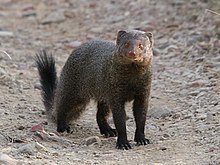Herpestes
| Herpestes | ||||||||||||
|---|---|---|---|---|---|---|---|---|---|---|---|---|

Herpestes javanicus |
||||||||||||
| Systematics | ||||||||||||
|
||||||||||||
| Scientific name | ||||||||||||
| Herpestes | ||||||||||||
| Illiger , 1811 |
Herpestes is agenus of carnivore from the mongoose family(Herpestidae). As the only genus in their family, it is alsowidespreadin southern and southeastern Asia and in southern Europe. The genus includes ten species, of which the two mongoose species ( Indian and small mongoose ) and the Ichneumon are the best known.
anatomy
The representatives of this genus have an elongated, slender trunk with short limbs. The color of their fur varies from yellowish to gray-green to brownish, with the flanks and the underside mostly being lighter, sometimes white. The tail is relatively long, all paws end in five toes, the hind paws are hairless. The head body length of these animals varies from 25 to 65 centimeters, the tail becomes 20 to 51 centimeters long and their weight is 0.5 to 4 kilograms.
distribution and habitat
The natural range of the animals of this genus includes almost all of Africa (except Madagascar ), the Arabian Peninsula and large parts of South and Southeast Asia . Ichneumons also live on the Iberian Peninsula , but the population there may have been introduced by humans. The two mongoose species were introduced to pest control in numerous regions of the world, including the Caribbean islands , Madagascar, Mauritius , Réunion and several Pacific islands .
These animals inhabit a wide variety of habitats, including forests and grasslands, but also arid desert regions.
Way of life
These animals mainly live on the ground, but some species can climb very well. Many are active during the day, but some also look for food at night. Hollow tree trunks, crevices or earthworks serve as resting places. Many species live in pairs or in family groups.
The diet consists of insects , crustaceans , fish , frogs , birds and small mammals , and they eat fruit as complementary food. Some species are famous for their tactics of hunting poisonous snakes . They let this happen again and again and skilfully avoid them, as soon as the snakes are tired, they can kill them.
Under favorable circumstances, the females can give birth to offspring two to three times a year, the gestation period is around 40 to 80 days, the litter size one to five. After a few weeks, the young are weaned and sexually mature at around one year.
Systematics
Ten species are distinguished within the genus:
- the ichneumon ( Herpestes ichneumon ) occurs in Africa and is the only species of mongoose in Europe
- the Indian mongoose ( Herpestes edwardsii ) inhabits parts of the Arabian Peninsula and the Middle East as well as the Indian subcontinent
- the little mongoose ( Herpestes javanicus ) is a relatively small species that is distributed from the Middle East to Indonesia
- the Indian red mongoose ( Herpestes smithii ) is similar to the Indian mongoose, but is slightly larger. Their fur is dark brown and often tinged with red. This species is native to India and Sri Lanka . To a greater extent than the other representatives, it lives in forests.
- the neck striped mongoose ( Herpestes vitticollis ) is the largest Asian mongoose species and lives in southern India and Sri Lanka. Their coat color varies from reddish brown to grayish brown, the black stripe along both sides of the neck is characteristic. It is diurnal and is often found near water.
- the crab mongoose ( Herpestes urva ) is common from northeast India to the Malay Peninsula . Their fur is grayish in color, white stripes extend from the mouth to the neck. The species is more adapted to an aquatic way of life and is nocturnal.
- the collar mongoose ( Herpestes semitorquatus ) is native to Sumatra and Borneo . Little is known about this species.
- the short-tailed mongoose ( Herpestes brachyurus ) lives on the Malay Peninsula , Sumatra, Borneo and Palawan . It has a greyish coat and a relatively short, thick tail.
- the Indian short-tailed mongoose ( Herpestes fuscus ) is externally very similar to the short-tailed mongoose and is sometimes only viewed as a subspecies. The species is native to southwest India and Sri Lanka.
However, the classification is not supported by genetic evidence. According to genetic analyzes of mitochondrial and nuclear DNA, the genus Herpestes is paraphyletic . The Asiatic Herpestes species should be placed in their own genus Urva . The long-nosed mongoose , which was originally also included in the genus Herpestes , is a distant sister species of the marsh mongoose and is therefore now in its own genus ( Xenogale ).
Hazardous situation
All species of this genus are listed by the International Union for Conservation of Nature IUCN in the Red List of Endangered Species . However, eight species are classified as “Least Concern”, insufficient data for one species (“Data Deficient”) for an assessment and only one species is listed as “Vulnerable”. (The query shows a total of 14 species; 4 of these species lists, however, can be assigned to the genus of the slender mongoose )
Individual evidence
- ↑ Marie-Lilith Patou, Patricia A. Mclenachan, Craig G. Morley, Arnaud Couloux, Andrew P. Jennings, Géraldine Veron: Molecular phylogeny of the Herpestidae (Mammalia, Carnivora) with a special emphasis on the Asian Herpestes. Volume 53, Issue 1, October 2009, Pages 69–80. online link .
- ^ Search for "Herpestes" in the IUCN Red List of Threatened Species 2009. Accessed January 26, 2010.
literature
- Ronald M. Nowak: Walker's Mammals of the World . Johns Hopkins University Press, Baltimore 1999. ISBN 0-8018-5789-9
- DE Wilson, DM Reeder: Mammal Species of the World . Johns Hopkins University Press, Baltimore 2005. ISBN 0-8018-8221-4

